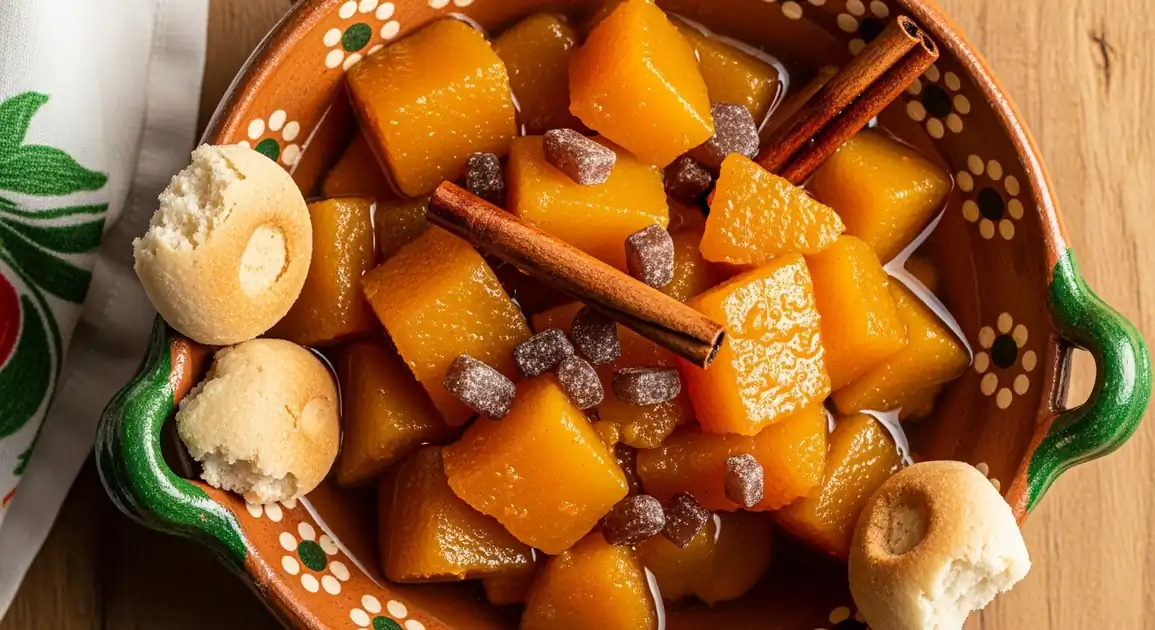Chilacayota
Chilacayote en Dulce

Description
In Oaxaca, chilacayota is especially significant, reflecting the region's rich culinary traditions and indigenous heritage. Oaxacan chilacayota often features a more complex spice profile and is frequently incorporated into important cultural events like Día de los Muertos and Guelaguetza. The preparation methods here tend to be more traditional, using clay pots and wood-fired cooking.
Dietary Information
Serving information
Serving style
In Oaxaca, chilacayota is often served in small clay bowls or jícaras (traditional gourd bowls). Commonly accompanied by pan de yema (Oaxacan egg bread) or other regional sweet breads for dipping in the syrup.
Quick facts
Market vendors: 8 AM - 6 PM. Sweet shops: 10 AM - 8 PM. Festival vendors during celebrations: often until 10 PM or later.
Safety Tips
What to Look For
-
Clean, covered containers for storage
Chilacayota should be stored in clean glass or food-grade containers with lids to protect from contaminants and insects.
-
Clear, amber-colored syrup
Quality chilacayota has a clear, amber-colored syrup without cloudiness, which indicates proper preparation and storage.
-
Visible cinnamon sticks or whole spices
The presence of whole spices rather than just ground spices often indicates more traditional, careful preparation.
-
Regular stirring or rotation of product
Vendors who occasionally stir or rotate their chilacayota ensure even distribution of syrup and prevent drying out of exposed pieces.
What to avoid
-
Fermentation bubbles or alcoholic smell
Bubbling or a fermented/alcoholic smell indicates that the chilacayota has begun to ferment and should not be consumed.
-
Cloudy or thickened syrup
Extremely cloudy or overly thickened syrup may indicate bacterial growth or excessive age.
-
Mold on the surface
Any visible mold on the chilacayota or its syrup means it should be avoided completely.
-
Crystallized sugar throughout
While some sugar crystallization is normal, excessive crystallization throughout indicates the dessert is too old or has been improperly stored.
Price information
Price range
Budget tips
- Markets like Central de Abastos offer the best value (20-30 MXN per serving).
- Local vendors in residential neighborhoods charge less than those in the Zócalo area.
- During festivals, prices may increase; buying from permanent vendors rather than temporary stalls is often more economical.
- Some vendors offer discounts when buying larger quantities.
Value indicators
- Dark amber color indicating proper cooking with piloncillo.
- Tender but firm squash pieces that hold their shape.
- Rich aroma of cinnamon and unrefined sugar.
- Served in traditional clay dishes for authentic presentation.
Where to Find This Dish
Central Markets
Mercado 20 de Noviembre and Mercado Benito Juárez feature dedicated sweet vendors with chilacayota.
Mercado 20 de Noviembre, Mercado Benito Juárez, Central de Abastos
Morning, Afternoon
Centro Histórico
Traditional sweet shops near the Zócalo offer high-quality, artisanal versions.
Zócalo, Andador Turístico, Cathedral
Afternoon, Evening
San Juan Chapultepec
This neighborhood is known for traditional food vendors with excellent regional sweets.
Local markets, Small family restaurants
Afternoon
Festival Locations
During major festivals, especially Day of the Dead, temporary vendors set up around pantheons and public squares.
Panteón General, Jardín Conzatti
Afternoon, Evening (during festivals)
Vendor Tips
- Look for vendors using traditional clay pots ('ollas de barro') rather than metal containers.
- Ask if they make it themselves ('¿Lo hace usted mismo?') to find authentic homemade versions.
- Vendors who sell a variety of traditional Oaxacan sweets usually make better quality chilacayota.
- During Day of the Dead, the freshest batches are prepared, making it an ideal time to try the best quality.
How to Order
Regional Variations
-
Chilacayota de la Sierra
(Chilacayota de la Sierra)
From the Sierra Norte region of Oaxaca, characterized by the addition of mountain herbs like hoja santa or hierba buena.
-
Chilacayota Mixteca
(Chilacayota Mixteca)
From the Mixtec region, known for using darker piloncillo and sometimes a touch of agave syrup.
-
Chilacayota con Panela Oaxaqueña
(Chilacayota con Panela Oaxaqueña)
Uses the distinctive Oaxacan unrefined sugar which imparts a unique regional flavor.
-
Chilacayota para Ofrenda
(Chilacayota para Ofrenda)
Specific preparation made for Day of the Dead altars, often more elaborately spiced and prepared with ritual significance.
Cultural context
History
Chilacayota has pre-Hispanic origins, as the chilacayote squash was cultivated by indigenous peoples in Mexico for thousands of years. After the Spanish introduction of cane sugar and cinnamon, preservation methods evolved to create this sweet delicacy. The tradition of preparing chilacayota became particularly associated with harvest season and Day of the Dead celebrations, when preserved fruits were practical offerings that could last throughout the ceremonial period. In Oaxaca, it has retained its cultural significance as both a daily sweet treat and an important ritual food.
Local significance
In Oaxaca, chilacayota is not just a dessert but a cultural symbol, particularly important during Day of the Dead celebrations when it's placed on altars and shared with family.
Eating customs
- In Oaxaca, it's common to enjoy chilacayota with traditional hot chocolate prepared with a molinillo (wooden whisk).
- The sweet is often eaten while discussing memories of departed loved ones during Day of the Dead.
- Some families maintain specific recipes passed down through generations.